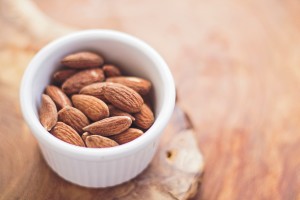This is the second post in our Coffee Nutrition and Health series. Our first post covered general health implications and nutrition of black coffee and you can read it here.
In our first post of the series Coffee Nutrition and Health we learned that coffee has no sugar, no fat, and zero to five calories. We also saw that coffee consumption is correlated with a host of health benefits and, to top it all off, that the latest US dietary guidelines give two thumbs up to three to five cups of coffee per day.
So we all cheered and ordered our fifth cup of brew for the day.
And chances are that fifth cup — or whatever number it is — probably isn’t black coffee.
All of the delightful information in our first post was about black coffee. And while we love black coffee, which can have an endless range of flavors depending on a number of factors (e.g. bean origin, type of processing and roasting, brew method), most Americans don’t drink their coffee solo. They typically mix coffee with other ingredients that change the nutrition of what they’re consuming. So now we’re going to our address these other ingredients — the ones that can be the key players when it comes to meeting your dietary goals.
This post, the second in the series, will focus on milk nutrition, and our third post will cover sweetening and/or flavoring coffee.
Milking Yo’ Milk
Most espresso drinks we sell at La Vita Dolce consist of coffee and milk (e.g. lattes, cappuccinos). The milk in your drink impacts taste/texture/body of the drink as well as its nutritional content. Switching the milk you use is often the easiest way to cut fat, calories, and sugar — or boost nutrients you may want, such as protein and Calcium.
The chart below shows key nutrition information for the most commonly used dairy and non-dairy milks.
Milk Nutrition (by Serving Size)
| Whole | Skim | Almond* | Soy* | Oat* | Coconut* | Half & Half (2 TBL) | |
|---|---|---|---|---|---|---|---|
| Calories | 150 | 90 | 30 | 110 | 180 | 45 | 40 |
| Fat | 8g | 0g | 2.5g | 4.5g | 8g | 4.5g | 3g |
| Sat. Fat | 5g | 0g | 0g | 0.5g | 1g | 4g | 2g |
| Carbs | 12g | 13g | 1g | 9g | 23g | 2g | 1g |
| Sugar | 11g | 12g | 0g | 6g | 3g | 1g | 1g |
| Fiber | 0g | 0g | 1g | 2g | 1g | 1g | 0g |
| Protein | 8g | 8g | 1g | 8g | 4g | 0g | 1g |
| Cholesterol | 35mg | 5mg | 0mg | 0mg | 0mg | 0mg | 15mg |
| Potassium | 380mg | 410mg | 160mg | 380mg | 260mg | 65mg | NA |
| Sodium | 120mg | 130mg | 150mg | 95mg | 160mg | 15mg | 20mg |
| Calcium | 30% | 30% | 45% | 45% | 6% | 10% | 4% |
| Vit A | 6% | 10% | 10% | 10% | NA | 10% | 2% |
| Vit D | 25% | 25% | 25% | 30% | NA | 30% | NA |
*Almond Milk shown is Almond Breeze Unsweetened Vanilla. Soy Milk is Silk Original. Oat Milk is Pacific Barista Series. Coconut is So Delicious Original.
You’re probably not going to memorize that chart. So below, we’ve provided an easily referenced list showing which milks are good options for a variety of dietary goals.
Low Calorie
Almond Milk
Coconut Milk
Low Sugar
Almond Milk
Coconut Milk
Low Fat
Skim Milk
Almond Milk
High Calcium / Vit A / Vit D
Whole Milk
Skim Milk
Almond Milk
Soy Milk
High Protein
Skim Milk
Whole Milk
Soy Milk
In a Nutshell: A Note on Almond Milk & Coconut Milk

While my aim is for you to find what’s best for you, I want to put in my two cents about milk — two cents that I would spend on almond milk.
You can see that almond milk appears more frequently as a “good dietary option” than any other milk in the above chart. Almond milk has just as much (or more) Calcium, vitamin A, and vitamin D as cow’s milk. It also has one fifth the calories of whole milk (and one third the calories of skim milk), it’s relatively low in fat, and it’s the only milk listed above that has NO sugar. This all adds up — or in the case of fat and sugar, prevents it from adding up — to almond milk being my go-to when prioritizing my health.
(If consuming high protein and/or low sodium are top goals for you, then almond milk may not be the best choice.)
While coconut milk has recently become more popular in coffee drinks, it’s the only milk listed above that La Vita Dolce does not carry. It’s not that we have an issue with coconut milk — we just have limited refrigerated storage space.
Given our limitations, we stock three non-dairy milks: almond, soy, and oat milk. Almond and soy tend to be better options when meeting customers’ nutritional preferences and we find oat milk to be the most neutral of the non-dairy milks. Coconut milk has less Calcium, vitamin A, and vitamin D than both almond milk and soy milk. It has more calories, fat, saturated fat, and sugar than almond milk and less protein and fiber than soy milk. Coconut milk is a great option for those whose top priority is cutting Sodium, but this isn’t a concern for most of our customers. So it’s the one that isn’t on in our limited refrigerated space.
Taste Test It Out
This series isn’t just about nutrition — it’s also about enjoyment. We want everyone to enjoy every coffee they drink. This means, if you’re drinking a latte, cappuccino, or other drink with milk, you should like the milk that’s in it. If you haven’t already, try different types of milk. You may even find that your preference varies with what you’re drinking. For example, one of our baristas who normally drinks cow’s milk prefers almond milk in her Dirty Spiced Apple Chai Latte. Also note that when milks are properly steamed, they change in texture and taste (e.g. they become sweeter) so the impact a given milk has on your drink will vary depending on how it’s prepared. So my suggestion is to test, test, test until you find a nutritional fit that also passes the taste test.
Our next post in the Coffee Nutrition and Health series is “Sweetening and Flavoring Solutions” and will discuss ways to have fun flavoring and/or sweetening your drink while not turning it into the nutritional equivalent of a sippable Snickers.

